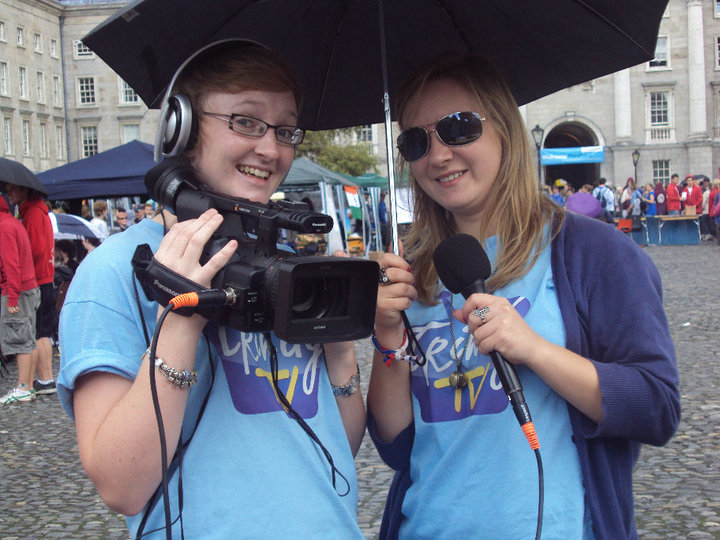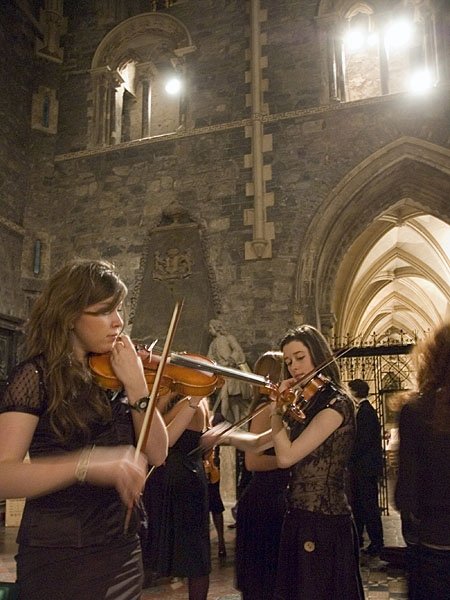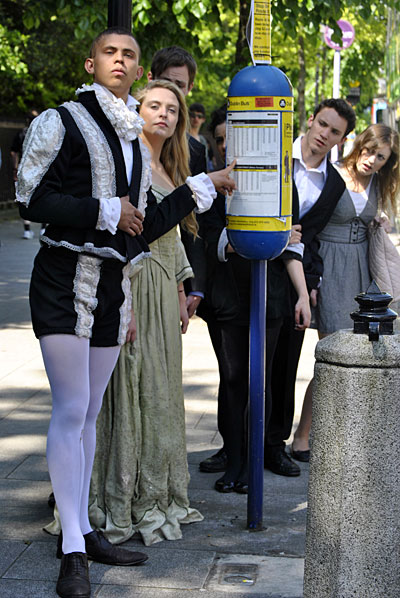Professor John O’Hagan and Johanna Archbold
Strategic Plan and the Student Experience
The importance of student clubs and societies is given much prominence in the College’s Strategic Plan, as evidenced by the following.
For many students the work that they do within clubs and societies is the single most important feature of their college lives, providing opportunities for friendship, social development and personal growth…The clubs and societies within the College paint a picture of what its students consider important to themselves, to their place in College, and to their place in the world.
It was in this context that we undertook over the last year research on student societies and clubs at Trinity, the report from which was launched on Tuesday 8 November 2011. The work for this report was funded by the J-P Foundation, London. Mr John Pearson, an enthusiastic member of the Rowing Club when in College in the 1950s, and a huge supporter since, was presented by the Provost with the first copy of the Report.
The Report provides a broad coverage of this very important aspect of the student experience in Trinity. The introduction examines the various benefits that can result from involvement in student societies and clubs and then in Chapter 1 provides a detailed outline of the structures in place at present in the College in relation to such activity, including involvement in student publications. Chapter 2 provides a lengthy discussion of the historical development of societies and clubs in Trinity and divides this into four periods: the Early Years to 1800, Nineteenth Century, Twentieth Century to 1960, and Recent Decades. Chapters 3 and 4 focus on a key subset of student societies with particular resonance in the Trinity and Ireland of 2011, namely arts/cultural activities such as performance, visual arts and literary and photographic, film and broadcast societies.
Long-Established Traditions
Sports facilities in some form developed in the College from 1650, with one of the earliest being a ‘tennis court’ (somewhere near today’s Aras an Phiarsaigh). The oldest of the official sports clubs dates from the 19th century and they had a major influence on Irish sport in those years, particularly in cricket, rugby, rowing and athletics. The report is replete with interesting anecdotal gems with regard to the history of these societies and clubs, as witnessed by the following.
Duelling was a common activity among the elite in Irish society in the sixteenth century and was part of campus life since the College’s foundation. Swords were worn as everyday dress and reports of duelling within College walls occur from the early seventeenth century to the early eighteenth century. The sport of fencing in Trinity developed from this period, promoted by Provost John Hely-Hutchinson (1774-94) through the “Gentleman’s Club of the Sword”. (P. 24)
A poem of Edward Lysaght’s, published in 1811, refers to evidence that football was played in College Park regularly in the 1780s. The Victorian period saw the development of many of the most prominent sports clubs today in the College. From the early 1800s the Hurling Club, the forerunner of the Dublin University Hockey Club, played in College Park. The Pavillion Bar (The Pav) was opened in 1885 as a result of funds provided by the Athletics Club.
Cricket was played at Trinity since at least the 1820s and in the 19th century College Park was the centre of Dublin cricket. The Rugby Club was founded in 1854. The Boat Club in its present form was founded in 1898 and secured at this time its premises and facilities at Islandbridge. The College Races had a prominent place in Dublin social life in the 19th century, as evidenced by the following!
Early race programmes were somewhat unorthodox in their approach to ‘athletics’ including the long-jump with trapeze, a Siamese race, a three mile walk and a cricket ball throw. The average attendance was 25,000 with seating for around 3,000. Among the prizes given were a gold pin, a love cup, an inkstand, a picnic basket and a walking stick. By the 1870s the festivities had, to College eyes, become unregulated and overrun by members of College over-influenced by “some cheap claret, beer and stout. (p. 31)
Many notable figures have been associated with sports in Trinity, one of the most distinguished being the playwright Samuel Beckett who excelled at cricket as a left-handed batsman and a left-arm medium-pace bowler, who has the distinction of being the only Nobel laureate to have an entry in the Wisden Cricketers’ Almanack, the ‘Bible’ of cricket.
The last quarter of the 18th century was the golden age of Irish eloquence, Edmund Burke being perhaps the best-know of the great orators of this period (yes, the person after whom the lecture theatre in the Arts Building is named). The formation of the College Historical Society in 1770, the first truly independent College society, was created out of his earlier club founded in 1747. Robert Emmet and Thomas Moore were early active members of the Hist.
The Phil has a loose connection to the Dublin Philosophical Society, founded in 1683, but only became an official College society in 1843. Famous former committee members include Bram Stoker, Oscar Wilde, John B. Yeats, David Norris and Paddy Cosgrave, founder of the recent very successful Dublin Web summit.
Wide Range of Societies & Clubs Today
This background has shaped the structure of Trinity’s societies and clubs to this day. While many, many new societies and clubs were added in the 20th century, the long-established societies and clubs still have a very prominent place in the Trinity of 2011. The Hist and the Phil remain the major student debating and paper reading societies in Ireland while rugby, hockey and cricket remain key sporting activities in the College.
Major changes in wider society have been reflected in the establishment of new clubs and societies. The admission of women into Trinity in 1904 was a significant development on campus, though it was not until the 1960s that many societies allowed them full membership. Political and cultural movements such as the Gaelic Revival were also reflected in student clubs and society activities. Increased student numbers, more diverse backgrounds and new interests have also led to many new and varied societies.
Arts/Cultural Societies
In the arts/cultural area, the focus of the larger part of the study, the long-established societies also still hold a prominent position. Apart from Choral, Players has played a very important role for almost 80 years in the College. The same applies for almost 50 years to the Arts Workshop, the Visual Arts Society, the Literary Society and the Photographic Society and several literary publications. But many new student music societies have been formed in this time, the Orchestral Society being particularly successful in recent years. We now also have radio, video, digital arts and TV societies.
Choral has the most distinguished history perhaps of these societies. Founded in 1837 it had a pivotal role in the Dublin social calendar throughout the 19th century with a number of their annual concerts attracting audiences of two to three thousand spectators.
By the Society’s Golden Jubilee in 1887 its public place in Dublin society was well-established. This significant anniversary coincided with that of Queen Victoria which furthered the Society’s prominence in Dublin during the celebrations of both. Throughout its history to this point the Society was very successful in attracting Patrons from the highest echelons of British and Irish society. After attending a performance by the Society during the royal visit of 1885, Edward Prince of Wales became its Patron until 1911 and was succeeded by George V between 1911 and 1938. (p. 55)
Concluding Observations
Societies and clubs align the student experience with John Henry Newman’s oft-cited and influential lecture “the Idea of a University” (1852, 1858) which highlighted the value of the broadest possible tertiary education. The activities of the societies can also represent a link between students and academic departments. As the activities of many of these societies are also open to the public, they can act as an additional tie between Trinity and the city, for example the Trinity Shakespeare Festival.
Trinity must adapt to changing circumstances, and yet not lose the benefits of its history in relation to student societies and clubs, as is indeed the situation with the College generally. Thus the innovation and energy that led to the creation of the College’s fine historic societies and clubs must be renewed, to maintain what is good from the past and to meet new challenges and student preferences. In particular, the ‘Trinity Experience’ must not come to represent empty rhetoric but something which as the Strategic Plan as seen earlier argues that students should see as the ‘single most important feature of their college lives, providing opportunities for friendship, social development and personal growth’. The Trinity Experience of course is not confined to Clubs and Societies (the subject matter of the Report) but wider extracurricular activity, including involvement in student union activity, charitable work and student publications, including of course this fine student newspaper.
Johanna Archbold is a Research Fellow, Long Room Hub, and John O’Hagan is Professor of Economics and President Student Economic Review (which he co-founded in 1987)









